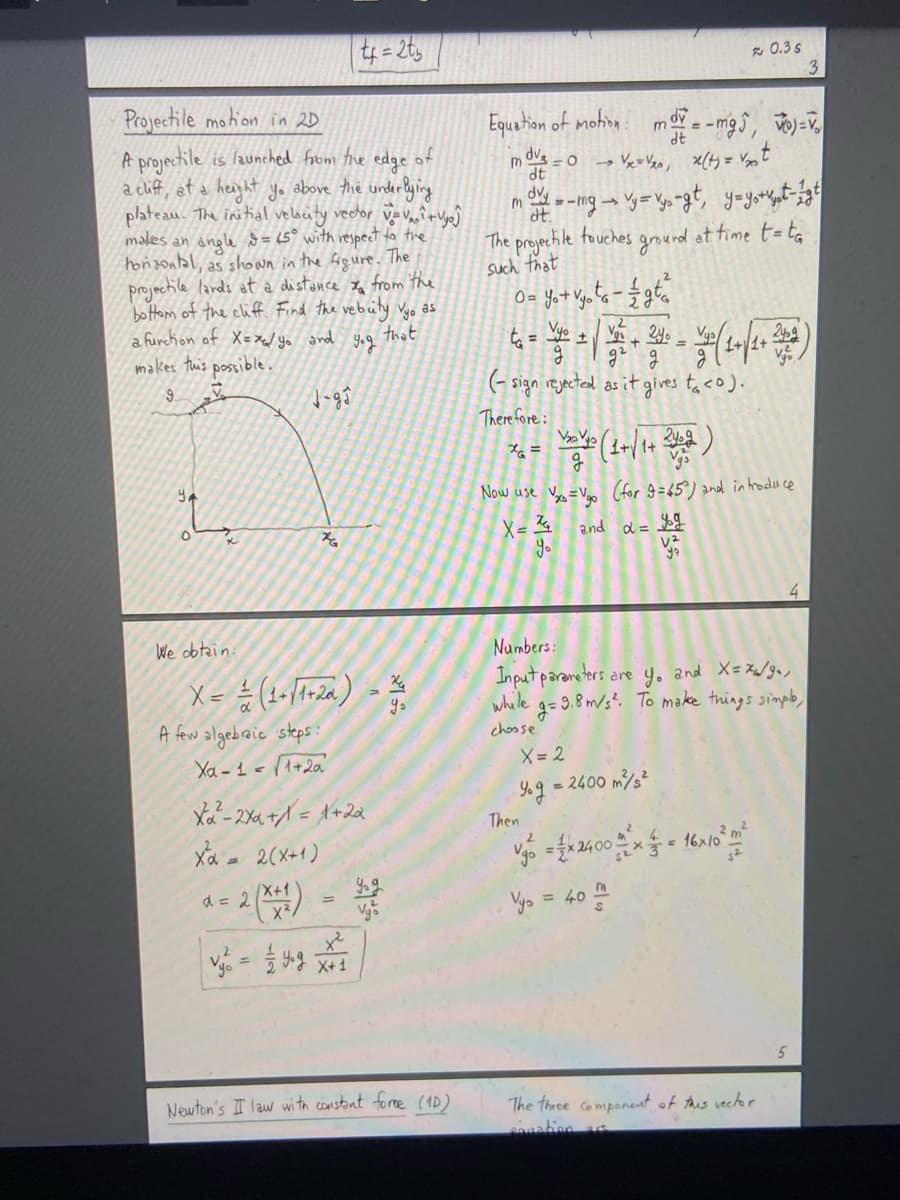Projectile motion in 2D A projectile is launched from the edge of a cliff, at a height yo above the underlying plateau. The initial velocity vector V=V₂₁ ²+ VyoĴ makes an angle = 45° with respect to the horizontal, as shown in the figure. The projectile lands at a distance from the bottom of the cliff. Find the vebuity vyo as a function of X=xel yo and yog makes this possible. that 9. لم YA L We obtain: 1-95 AG X = = = (1+11+20) A few algebraic steps: Xa-1 =√1+2a Vy = / Yog X2²-2X2+1=X+22 Xα = 2(x+1) d = 2 = 275 yo 34 Newton's II law with constant force (10) Equation of motion: md=-mg )= V dt m → Vx=V₂0, X(t) = √₂+ dvy m мон o-ng - Yo Yongt, утунцаћи де dt. dv₁ = 0 dt The projectile touches ground at time t= ta such that 0=yo+vyotg Vyeo ± √ V 24 Vy g² g = (-sign rejected as it gives to <0). Therefore: XG = V Yoyo (1+1/1+ 2002) g Now use =V₂ (for 9=45°) and introduce and d = X = 26 yo Numbers: while Input parameters are y. and X= 7₂/9₁, g=9.8 m/s². To make things simple, choose X = 2 Yog Then = 2400 m/s² vz Vyo = 40 The three component of this vector equation as 5
Projectile motion in 2D A projectile is launched from the edge of a cliff, at a height yo above the underlying plateau. The initial velocity vector V=V₂₁ ²+ VyoĴ makes an angle = 45° with respect to the horizontal, as shown in the figure. The projectile lands at a distance from the bottom of the cliff. Find the vebuity vyo as a function of X=xel yo and yog makes this possible. that 9. لم YA L We obtain: 1-95 AG X = = = (1+11+20) A few algebraic steps: Xa-1 =√1+2a Vy = / Yog X2²-2X2+1=X+22 Xα = 2(x+1) d = 2 = 275 yo 34 Newton's II law with constant force (10) Equation of motion: md=-mg )= V dt m → Vx=V₂0, X(t) = √₂+ dvy m мон o-ng - Yo Yongt, утунцаћи де dt. dv₁ = 0 dt The projectile touches ground at time t= ta such that 0=yo+vyotg Vyeo ± √ V 24 Vy g² g = (-sign rejected as it gives to <0). Therefore: XG = V Yoyo (1+1/1+ 2002) g Now use =V₂ (for 9=45°) and introduce and d = X = 26 yo Numbers: while Input parameters are y. and X= 7₂/9₁, g=9.8 m/s². To make things simple, choose X = 2 Yog Then = 2400 m/s² vz Vyo = 40 The three component of this vector equation as 5
University Physics Volume 1
18th Edition
ISBN:9781938168277
Author:William Moebs, Samuel J. Ling, Jeff Sanny
Publisher:William Moebs, Samuel J. Ling, Jeff Sanny
Chapter2: Vectors
Section: Chapter Questions
Problem 61P: In the control tower at a regional airport, an air traffic controller monitors two aircraft as their...
Related questions
Question
My question is that I don’t understand what happened in the second page from where it says we obtain:
I get how we got X but I don’t get how we get alpha in the first page and then use it in the second page till we get the final formula if you can please show me the steps of finding the final formula

Transcribed Image Text:Projectile motion in 2D
A projectile is launched from the edge of
a cliff, at a height yo above the underlying
plateau. The initial velocity vector V=V₂ î+ Vyo
makes an angle = 45° with respect to the
horizontal, as shown in the figure. The
projectile lands at a distance from the
bottom of the cliff. Find the vebuity vyo as
a function of X=xyo and Yog
makes this possible.
that
9
ya
L
O
2
We obtain:
1-91
AG
t=2₂
X = (1-11-2a) - 3
A few algebraic steps:
Xa-1 =√1+2a
X2²-2X2 + 1 = 1+22
Xα = 2(x+1)
a= 2 (2x²) = 3²
j²
X+1
Newton's II law with constant force (10)
Equation of motion: md=-mg 5₁ )= V₁
dt
m
dv₁ = 0 → √x = √₂0, x(+) = √₂st
dt
dvy
md=-mg → vy=vy-gt, y=y+t-1
dt.
The projectile touches ground at time t= to
such that
≈ 0.3s
3
Therefore:
,2
0-%-%-²
5- ² - 1 3 - 34²-(1-/14+ 26²)
t₁ =
=
g² g
(-sign rejected as it gives to <0).
V
74= -2²0 (1-/14 364)
XG=
1+
Now use =V₂ (for 9=45") and introduce
X = 24₂
Yo
and a g
V²
X = 2
Yog = 2400 m²/s²
Numbers:
Input parameters are y. and X= 7₂/9₁,
while g= 3.8 m/s². To make things simple,
choose
Then
Vo = x 2400 = x= 16×10² m²
Vyo = 40 m
The three component of this vector
equation are
4
5
Expert Solution
This question has been solved!
Explore an expertly crafted, step-by-step solution for a thorough understanding of key concepts.
Step by step
Solved in 4 steps with 4 images

Follow-up Questions
Read through expert solutions to related follow-up questions below.
Follow-up Question
my question was also how did we get alpha to begin with so that we can substitute it
Solution
Knowledge Booster
Learn more about
Need a deep-dive on the concept behind this application? Look no further. Learn more about this topic, physics and related others by exploring similar questions and additional content below.Recommended textbooks for you

University Physics Volume 1
Physics
ISBN:
9781938168277
Author:
William Moebs, Samuel J. Ling, Jeff Sanny
Publisher:
OpenStax - Rice University

University Physics Volume 1
Physics
ISBN:
9781938168277
Author:
William Moebs, Samuel J. Ling, Jeff Sanny
Publisher:
OpenStax - Rice University